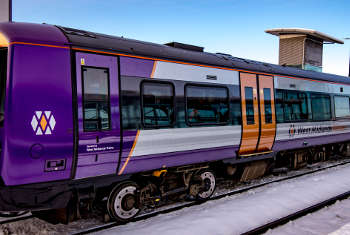Key figures in the transport sector have called for increased investment in rail alongside ticketing reform as statistics reveal seating capacity is falling behind long-term demand growth.
New Department for Transport statistics on ‘rail passenger numbers and [over]crowding’ show that passenger arrivals increased in most major cities last year.
Officials said: ‘This is in line with the growth in rail journeys seen in recent years.’

West Midlands Train had the most overcrowded service
As previously reported, rail passenger numbers in Great Britain reached a record high in 2018/19.
The new statistics show that more than 230,000 passengers were standing on trains during peak hours in London. In other cities the number of standing passengers was much lower.
Officials said the percentage of passengers standing has grown across seven major cities.
Across all major cities included in the data, 17% of passengers were standing in the peaks.
Officials added that since 2010, total passenger demand in the morning peak has grown faster than seats in every city except for Bristol and Newcastle.
Darren Shirley, chief executive of Campaign for Better Transport, said: ‘Peak-time rail is bursting at the seams. With 17% of commuters not getting a seat, too many people are paying thousands of pounds to stand in aisles, vestibules and even toilet cubicles.
‘To reduce overcrowding and make sure passengers get value for their ticket we must continue to invest in better stations, track and rolling stock. But to avoid congestion, train users also need innovation like advance notice of the busiest trains and pay-as-you-go ticketing which increases flexibility about when they travel.’
The document notes that: 'Research shows that being able to get a seat on a train is a top priority for passengers.' However, standing passengers do not necessarily mean that trains are counted as overcrowded as capacity includes standing space.
In fact, officials noted that: ‘On some routes, particularly those which serve commuters, train companies use rolling stock that are designed with a higher capacity of standing space.’
This of course means that some trains have fewer seats and may explain why overcrowding remains relatively stable. Officials said 3.5% of passengers were in excess of capacity overall during peak hours, the same as last year.
Regional rail
Separately, the Urban Transport Group’s Number Crunch 2019 shows that regional rail use, which includes most local services in the metropolitan areas, has increased by 29% since 2008/09, hitting 389 million passengers journeys in 2017/18, which it called a ‘remarkable success story’.
Darren Caplan, chief executive of the Railway Industry Association, which represents the UK rail supply industry, said: ‘This report is a timely reminder of the Railway Industry Association’s repeated assertions of the need to urgently grow the UK’s rail network through supporting major rail projects and enhancement schemes.
‘The report shows that the number of people using regional rail has increased dramatically in the last 10 years all over the country, and that where there has been investment in rail, growth has been more pronounced.’
Register now for full access
Register just once to get unrestricted, real-time coverage of the issues and challenges facing UK transport and highways engineers.
Full website content includes the latest news, exclusive commentary from leading industry figures and detailed topical analysis of the highways, transportation, environment and place-shaping sectors.
Use the link below to register your details for full, free access.
Already a registered? Login